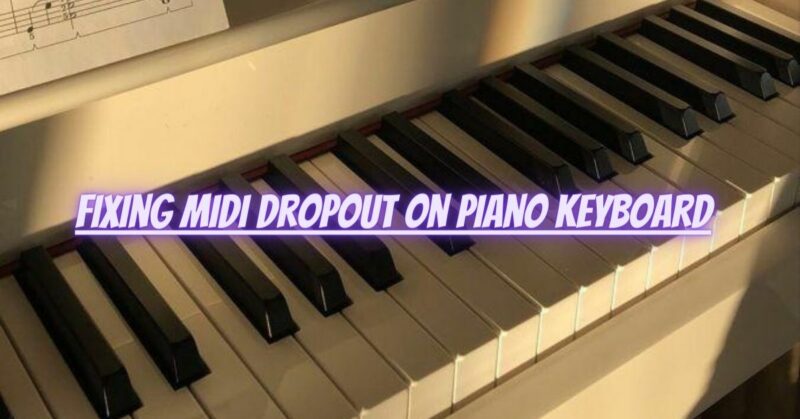MIDI dropout, the sudden interruption of MIDI data transmission between your piano keyboard and connected devices, can be frustrating for musicians and disrupt the creative process. MIDI is a crucial communication protocol that enables your piano keyboard to interact with computers, digital audio workstations (DAWs), and other MIDI-compatible devices. In this article, we’ll explore common causes of MIDI dropout on a piano keyboard and provide practical solutions to troubleshoot and resolve the issue.
1. Loose or Damaged MIDI Cables:
Unstable or damaged MIDI cables can result in intermittent MIDI dropout.
Solution:
- Check all MIDI cables and connectors for secure connections.
- Replace any damaged cables with high-quality, shielded MIDI cables to ensure reliable data transmission.
2. Insufficient Power Supply:
A weak or unstable power supply can cause MIDI dropout on some MIDI devices, including keyboards.
Solution:
- Ensure your piano keyboard is connected to a reliable and adequate power source.
- Avoid using long extension cables or power strips that may cause voltage drops.
3. Interference and Grounding Issues:
Electrical interference or improper grounding can disrupt MIDI data transmission.
Solution:
- Keep your piano keyboard away from sources of electrical interference, such as fluorescent lights, motors, or other electronic devices.
- Use high-quality power outlets with proper grounding to minimize interference.
4. MIDI Thru/Out Port Overload:
If your piano keyboard has multiple MIDI ports, excessive data flow through the MIDI Thru or Out port may cause dropout.
Solution:
- Reduce the MIDI data flow by disconnecting unnecessary MIDI devices from the Thru/Out ports.
- Use a MIDI interface or MIDI splitter if you need to connect multiple devices to your piano keyboard.
5. Firmware and Software Updates:
Outdated firmware or software on your piano keyboard or connected devices can lead to compatibility issues and MIDI dropout.
Solution:
- Check the manufacturer’s website for any available firmware or software updates for your piano keyboard.
- Update both the piano keyboard and connected devices to the latest versions to ensure optimal compatibility.
6. MIDI Buffer Settings:
Incorrect MIDI buffer settings in your DAW or MIDI interface can contribute to MIDI dropout.
Solution:
- Adjust the MIDI buffer size in your DAW or MIDI interface settings. A larger buffer size can help reduce MIDI dropout, but it may introduce latency.
- Find a balance between buffer size and latency that works best for your specific setup.
7. MIDI Channel Conflicts:
MIDI channel conflicts between your piano keyboard and connected devices can cause data collision and dropout.
Solution:
- Ensure that your piano keyboard and all connected MIDI devices are set to different MIDI channels to avoid conflicts.
Conclusion:
MIDI dropout on a piano keyboard can often be resolved by checking and securing MIDI connections, ensuring sufficient power supply, and addressing grounding issues. Keeping your piano keyboard away from sources of interference and updating firmware and software are also crucial steps. If the problem persists, examining MIDI buffer settings, channel conflicts, and using proper MIDI interfaces can further improve reliability. With diligent troubleshooting and attention to detail, you can minimize MIDI dropout and enjoy uninterrupted communication between your piano keyboard and connected devices, allowing you to focus on your music without any interruptions.


